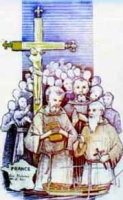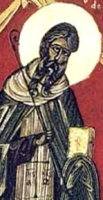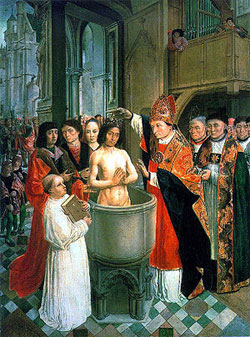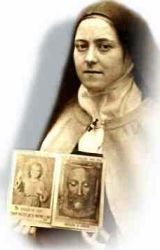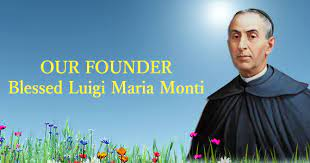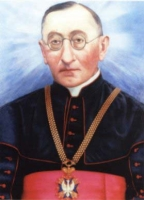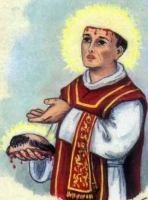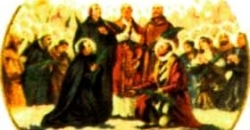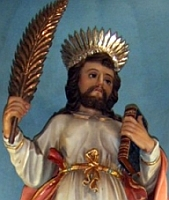Guardian Angels
தூய காவல் தேவதூதர்களின் நினைவு
(Memorial of the Holy Guardian Angels)
நினைவுத் திருவிழா: அக்டோபர் 2
தூய காவல் தேவதூதர்களின் நினைவுத் திருநாள் என்பது, கத்தோலிக்க திருச்சபையினால் அனுசரிக்கப்படும் நினைவுத் திருநாட்களில் ஒன்றாகும். அக்டோபர் மாதம் 2ம் தேதி அனுசரிக்கப்படும் இந்நினைவுத் திருநாளானது, சில இடங்களில், “தெய்வீக வணக்கத்திற்கான சபையின்” (Congregation for Divine Worship) அனுமதியுடன் செப்டம்பர் மாதத்தின் முதல் ஞாயிறன்று அனுசரிக்கப்படுகின்றது. கத்தோலிக்கர்கள், கி.பி. 4ம் நூற்றாண்டின் ஆரம்பத்தில் பாதுகாவல் தேவதூதர்களை நினைத்து பலிபீடங்களை அமைத்தனர். மற்றும், காவல் தேவதூதர்களை கௌரவப்படுத்துவதற்கான உள்ளூர் கொண்டாட்டங்கள், கி.பி. 11ம் நூற்றாண்டிற்கு பின்னோக்கிச் செல்கின்றன. இந்நினைவுத் திருவிழாவானது, “ஆங்கிலிகன் சமூகத்திலுள்ள” (Anglican Communion) சில “ஆங்கிலோ-கத்தோலிக்கர்களாலும்” (Anglo-Catholics), தொடர்ந்து “ஆங்கிலிகன் இயக்கத்தின்” (Anglican movement) பெரும்பாலான சபைகளாலும் பின்பற்றப்படுகிறது.
தேவதூதர்களுக்கான பக்தி என்பது, யூத மதத்திலிருந்து கிறிஸ்தவ திருச்சபைகளுக்குப் பெறப்பட்ட ஒரு பண்டைய பாரம்பரியம் ஆகும். இந்நினைவுத் திருநாளானது, ஆரம்பத்தில் “ஃபிரான்சிஸ்கன் சபையினரால்” (Franciscan Order) கி.பி. 1500ம் ஆண்டில் அனுசரிக்கப்பட்டது. கி.பி. 1607ம் ஆண்டு “பொது ரோம நாள்காட்டியில்” திருத்தந்தை “ஐந்தாம் பவுல்” (Pope Paul V) அவர்களால் இந்நினைவுத் திருவிழா நிலை நிறுத்தப்படும்வரை, இன்ன பிற நினைவுத் திருவிழாக்கள் போலவே, இதுவும் உள்ளூர் கொண்டாட்டமாகவே இருந்தது. 1976ம் ஆண்டிலிருந்து இது நினைவுத் திருநாளாக கொண்டாடப்படுகிறது.
ஒரு தேவதூதர் தமது சிறு குழந்தைகளை உண்மையான, மற்றும் கற்பனையான ஆபத்துகளிலிருந்து காப்பாற்றுகிறார் என்பது கத்தோலிக்க பெற்றோரிகளின் பெரும் ஆறுதலளிக்கும் அம்சமாக அமைந்துள்ளது. பாதுகாவல் தேவதூதர் என்பவர், சிறு பிள்ளைகளுக்கானவர் மட்டுமல்லர்.
காவல் தேவதூதர்களின் முக்கிய பணிகளாவது, கடவுளுக்கு முன்பாக தாம் பாதுகாப்பவர்களை பிரதிநிதித்துவம் செய்வதுவும், எப்பொழுதும் அவர்களைக் கண்காணிப்பதுவும், அவர்களுக்கு அவர்களுடைய ஜெபத்திற்கு உதவுவதும், மற்றும் அவர்கள் மரித்தபோது அவர்களுடைய ஆன்மாவை கடவுளுக்கு முன்நிறுத்துவதுமாகும்.
ஒரு காவல் தேவதூதனின் எண்ணமானது, ஒவ்வொரு மனிதனையும் வழிநடத்துவதும், வளர்ப்பதுமாகும். இது கத்தோலிக்கக் கோட்பாடு மற்றும் புனித நூல்களை அடிப்படையாகக் கொண்ட பக்திவிருத்தியாகும்.
மத்தேயு 18:10-ல் இயேசுவின் வார்த்தைகள் இவ்விசுவாசத்தை ஆதரிக்கின்றன:
“இச்சிறியோருள் ஒருவரையும் நீங்கள் இழிவாகக் கருதவேண்டாம்; கவனமாயிருங்கள்! இவர்களுடைய வானதூதர்கள் என் விண்ணகத் தந்தையின் திருமுன் எப்பொழுதும் இருக்கின்றார்கள் என நான் உங்களுக்குச் சொல்லுகிறேன்.”
இது துறவற மரபுகளின் பிறப்புடன் வளரத் தொடங்கிய நினைவுத் திருநாளாகும். புனிதர் பெனடிக்ட் (Saint Benedict) அதை ஊக்கப்படுத்தினார். மற்றும் 12ம் நூற்றாண்டின் பெரிய சீர்திருத்தவாதியான “கிளைர்வாஸின் புனிதர் பெர்னார்ட்” (Saint Bernard of Clairvaux) தமது நாட்களில் தேவதூதர்களின் பக்தியை எடுத்துக் கொண்டதற்கான சிறந்த சொற்பொழிவாளர் ஆவார்.
விடுதலைப் பயண நூலிலிருந்து வாசகம் 23: 20-23ய
ஆண்டவர் கூறுவது: வழியில் உன்னைப் பாதுகாக்கவும், நான் ஏற்பாடு செய்துள்ள இடத்தில் உன்னைக் கொண்டு சேர்க்கவும், இதோ நான் உனக்கு முன் ஒரு தூதரை அனுப்புகிறேன். அவர்முன் எச்சரிக்கையாயிரு; அவர் சொற்கேட்டு நட; அவரை எதிர்ப்பவனாய் இராதே. உன் குற்றங்களை அவர் பொறுத்துக் கொள்ளார். ஏனெனில், என் பெயர் அவரில் உள்ளது. நீ அவர் சொல் கேட்டு நடந்தால், நான் சொல்வது யாவற்றையும் கேட்டுச் செயல்பட்டால், நான் உன் எதிரிகளுக்கு எதிரியும், உன் பகைவர்க்குப் பகைவனும் ஆவேன். ஏனெனில், என் தூதர் உனக்கு முன் செல்வார்.
மறையுரைச் சிந்தனை:
கடவுள் நம்பிக்கையுள்ள ஒருவர் காட்டுவழியாக பயணம் மேற்கொண்டார். அது ஓர் அடர்ந்த, கொடிய மிருகங்கள் வாழக்கூடிய காடு. அவர் தன் பயணத்தைத் தொடர்கையில் திடிரென்று இருள்சூழ்ந்து கொண்டது; மழைபெய்யும் அறிகுறிகள் வேறு தென்பட்டன. இடிமுழக்கத்துடன், காட்டுவிலங்குகளின் சத்தமும் ஒருசேர அவரை பீதிக்கு உள்ளாக்கியதால், அவருக்குள்ளே ஒருவிதமான பய உணர்வு ஏற்பட்டது. முடிவில் அவர் மயங்கி கீழே விழுந்தார்.
அவர் மீண்டும் கண்விழித்துப் பார்த்தபோது, அவர் செல்லவேண்டிய இடத்தை அடைந்திருந்தார். அவருக்கு ஆச்சரியம் தாங்கமுடியவில்லை. என்ன நிகழ்ந்தது என அவர் சிந்தித்த போது அவருக்கு ஒரு அசரீரி ஒலி கேட்டது.
”மகனே நீ உன் பயணத்தைத் தொடர்ந்தபோது, அதன் பாதுகாப்பை என்னிடம் ஒப்படைத்துச் செபித்தாய், அக்கணம் முதலே நான் உன்னைப் பின்தொடர்ந்து வந்தேன். நீ பயணித்த பாதையின் பாதச்சுவடுகளை உற்றுப்பார், உன்பின்னே மேலும் இரு பாதப்பதிவுகளைக் காணலாம். நான்காகத் தொடர்ந்த பாதச்சுவடுகள் நீ மயங்கிய இடத்திலிருந்து இரண்டாகக் குறைந்துள்ளதை காண்பாய். நீ நிலைகுலைந்து, மயங்கி, நிலத்தில் விழ நான் இடமளிக்கவில்லை. மாறாக, நான் உன்னை என் கரங்களில் தாங்கிக் கொண்டேன். அதன்பின் உன்னால் நடந்து உன் பயணத்தைத் தொடர முடியாததால், என் தோள்களில் உன்னைச் சுமந்துவந்தேன். அந்த இரண்டு பாதச்சுவடுகளும் உன்னுடையதல்ல, உன்னைச் சுமந்த என்னுடையதே. உனக்குத் தெரியாமலே நான் உன்னுடன் பயணித்தேன் என்றது” அந்த அசரீரி.
நீ செல்லும் இடமெல்லாம் உன்னைக் காக்கும்படி அவர் தம் தூதர்களுக்குக் கட்டளையிட்டுள்ளார் என்ற இறைவார்த்தையை (திபா 91:11) உறுதி செய்வதாக இருக்கிறது மேலே சொல்லப்பட்ட நிகழ்வு. ஆம், இறைத்தூதர்கள் நம்மை பாதுகாக்கக்கூடியவர்கள்; நமக்குத் துணையாய் இருப்பவர்கள், நம்மோடு வழிநடப்பவர்கள். அப்படிப்பட்ட சிறப்புகளுக்குச் சொந்தக்காரர்களான காவல் தூதர்களின் விழாவை இன்று நாம் கொண்டாடுகின்றோம்.
திருச்சபையின் தந்தையர் என அழைக்கப்படுகின்ற அகுஸ்தினார், அக்வினாஸ், எரேனியு போன்றவர்கள் ஒவ்வொருவருக்கும் ஒரு காவல் தூதர் இருக்கிறார் என்று சொல்வார்கள். ஆனால் விவிலியத்திலே அதற்கான ஆதாரம் கிடையாது. “இச்சிறியோருள் ஒருவரையும் நீங்கள் இழிவாகக் கருதவேண்டாம். கவனமாயிருங்கள்! இவர்களுடைய வானதூதர்கள் என் விண்ணகத் தந்தையின் திருமுன் எப்பொழுதும் இருக்கின்றார்கள் என நான் உங்களுக்குச் சொல்கிறேன்” (மத்தேயு 18:10) என்னும் இயேசுவின் வார்த்தைகள்தான் காவல்தூதர்கள் இருக்கிறார்கள் என்பதற்கான மையக் கருவாக இருக்கின்றது.
இந்த காவல்தூதர்கள் வழியாக இறைவன் நமக்கு உணர்த்தும் வாக்குறுதி 'உன்னை விட்டு விலகுவதுமில்லை, உன்னைக் கைவிடுவதுமில்லை' என்பதுதான். காவல் தூதர்கள் நம்மோடு இருக்கிறார்கள், நம்மை என்றும் வழிநடத்துகிறார்கள். மேலும் இவர்கள் கடவுளின் செல்லப்பிள்ளைகளைக் காப்பாற்றுபவர்களாகவும் (2 அரசர்கள் 6:13-17), தகவல்களை வெளிப்படுத்துபவர்களாகவும் (லூக் 1:11-20), வழிகாட்டுபவர்களாகவும் (மத் 1:20-21), பராமரிப்பவர்களாகவும் (1 அர 19:5-7), பணிவிடை செய்பவர்களாகவும் (எபி 1:14) வலம் வருகின்றனர். ஆதலால் இவ்வளவு பணிகளை நமக்காக செய்துவரும் காவல் தூதர்களை நினைத்து இறைவனுக்கு நன்றி செலுத்தவேண்டும்; அவருக்கு என்றும் பிரமாணிக்கமாய் இருக்கவேண்டும்.
சிறுவன் ஒருவன் விடுமுறைக்கு தன்னுடைய பாட்டியின் வீட்டிற்குச் சென்றிருந்தான். பாட்டியின் வீட்டில், ஒரு அறையில் கடவுளின் படம் ஒன்று மாட்டப்பட்டிருந்தது. அதற்கு கீழே, “கடவுள் உன்னை கவனித்துக் கொண்டிருக்கிறார் என்று எழுதியிருந்தது.
இது சிறுவனுக்கு மிகப்பெரிய மன உளைச்சலைத் தந்தது. “கடவுள் என்னைக் கவனித்துக் கொண்டிருக்கிறார் என்றால், என்னால் சேட்டைகள் செய்ய முடியாது, நான் ஒழுக்கமுடையவனாக அல்லவா வாழவேண்டும்” என்று தன்னுடைய பாட்டியிடம் முறையிட்டான் அவன். அதற்கு அவனுடைய பாட்டி, “கடவுள் உன்னைக் கவனித்துக் கொண்டிருக்கிறார் என்பதற்கு அது விளக்கமல்ல, மாறாக கடவுள் உன்னை சிறு நொடிப்பொழுதும் கைவிடாமல் பாதுகாத்து அன்பு செய்கிறார் என்பதே இதன் அர்த்தம்” என்று விளக்கமளித்தார்.
ஆம், காவல் தூதர்கள் நம்மோடு இருக்கிறார்கள் என்றால் கடவுள் எப்போதும் கண்காணித்துக்கொண்டே இருக்கிறார் என்று அர்த்தமல்ல, மாறாக அவர் நம்மை சிறுபொழுதும் பிரியாமல் பாதுகாத்து அன்பு செய்கிறார் என்பதே அர்த்தம்.
எனவே நம்மை காவல் தூதர்கள் வழியாக பராமரித்து வரும் இறைவனுக்கு நன்றி செலுத்துவோம். அத்தோடு காவல்தூதர்களின் உடனிருப்பை உணர்வோம்; இறைவழியில் நடந்து, இறையருள் பெறுவோம்.
Profile
The term guardian angels refers to the belief that each person has an angel who is available to shepherd their soul through life, and help bring them to God.
Belief in the reality of angels, their mission as messengers of God, and man's interaction with them, goes back to the earliest times. Cherubim kept Adam and Eve from slipping back into Eden; angels saved Lot and helped destroy the cities of the plains; in Exodous Moses follows an angel, and at one point an angel is appointed leader of Israel. Michael is mentioned at several points, Raphael figures large in the story of Tobit, and Gabriel delivered the Annunciation of the coming of Christ.
The concept of each soul having a personal guardian angel, is also an ancient one, and long accepted by the Church
See that you despise not one of these little ones [children]: for I say to you, that their angels in heaven always see the face of my Father who is in heaven. - Jesus, Matthew 18:10
How great the dignity of the soul, since each one has from his birth an angel commissioned to guard it. - Saint Jerome in his commentary on Matthew
Are they not all ministering spirits, sent to minister for them, who shall receive the inheritance of salvation? - Hebrews 1:14
The feast celebrating the angels who helped bring us to God began in many local calendars centuries ago, and was widely known by the 16th century. Pope Paul V placed a feast venerating the angels on the general calendar on 27 September 1608. Ferdinand of Austria requested that it be extended to all areas in the Holy Roman Empire. Initially placed after the feast of Michael the Archangel, it was seen as a kind of supplement to that date. Pope Clement X elevated the feast, celebrated 2 October, to an obligatory double for the whole Church. On 5 April 1883, Pope Leo XIII raised the feast to the rank of a double major.
Blessed Antoine Chevrier
Profile
An only child in a family of workers in the silk industry, Antoine was baptized at the age of two days. He made his First Communion in 1837, and in 1840, at age 14, he considered becoming a priest – and had such a sense of happiness at the idea that he knew he had a calling to the priesthood. He began his seminary studies in 1842. While studying, he considered joining the foreign missions, but his mother threatened to disown him. "Do you think I raised you for you to be eaten by savages?", she demanded. "Savages you can find in Lyon!" He was ordained a priest in the archdiocese of Lyon, France on 25 May 1850.
Father Antoine's first assignment was to the parish of Saint-André de la Guillotière, an area of the poorest of Lyon's poor. There he dedicated himself to helping the poor, relieving some of the spirit-grinding misery in which they lived, and convincing others to do the same. He preached against greed, helped organize charity, and on Christmas Eve 1856, while meditating before a Nativity creche and contemplating the humble beginnings of Christ on Earth, he felt a call to not just work with the poor himself, but to organize a religious congregation for others with the same dedication. In January 1857 he sought the counsel of Saint John Marie Vianney on the matter, and the Cure of Ars encouraged him follow the call. Chevrier received permission to leave parish work, and with the help of the layman Camille Rambaud, he began working with and sheltering poor children, abandoned children, factory working children, and those who had already been sent to prison as children.
He joined the Franciscan Third Order in 1859, and on 10 December 1860 he purchased an old ballroom and converted it to a chapel, shelter and school for poor children. During his lifetime he personally worked with around 2,400 boys and young men. In 1866 he opened a school for the boys who felt a call to priestly or religious life, and to teach them to work with young poor people; the group became the Institute of the Priests of Prado, and the female branch, the Sisters of Prado opened soon after; the two groups were often known as the Work of Prado. The first of the Priests of Prado were ordained in Rome, Italy in 1876.
Father Antoine helped quell civil unrest in Lyon in 1871 by leading a Eucharistic procession thorugh the streets on the Feast of Corpus Christi; no one on either side of the conflict dared disrupt such an event. Chevrier wrote the books Disciple of Jesus Christ and God Sends Revolutions, which was a critique of priests who were devoted to comfort, worldly goods or careerism. Though Antoine did not live to see it, the Work received diocesan approval in 1924, was made part of the Conventual Franciscans in 1930, received a decree of papal praise for their work by Pope John XXIII on 28 October 1959, and continues its good work today in dozens of countries.
Born
Easter Sunday, 16 April 1825 in Lyon, Rhône, France
Died
• 2 October 1879 in Lyon, Rhône, France of natural causes
• around 10,000 people attended his funeral, many of them the people the Work of Prado had helped
• he was buried in the chapel he had built, and the street in front of it is now named for him
Beatified
4 October 1986 by Pope John Paul II
Saint Leodegarius of Autun
புனிதர் லியோடெகர் அல்லது லெகர்
ஆடொன் மறைமாவட்ட ஆயர் & மறைசாட்சி:
பிறப்பு: கி.பி. 615
ஆடொன், ஸாவொன்-எட்-லொய்ர், பர்கண்டி, ஃபிரான்ஸ்
இறப்பு: அக்டோபர் 2, 679
சார்சிங், சொம், பிக்கார்டி, ஃபிரான்ஸ்
ஏற்கும் சமயம்:
ரோமன் கத்தோலிக்க திருச்சபை
கிழக்கு மரபுவழி திருச்சபை
நினைவுத் திருநாள்: அக்டோபர் 2
பாதுகாவல்:
குருட்டுத்தனத்திற்கு எதிராகத் தூண்டுதல்; கண் நோய்; கண் பிரச்சினைகள்;
ரணமான கண்கள்.
புனிதர் லியோடெகர் அல்லது லெகர், ஒரு மறைசாட்சியாக கொல்லப்பட்ட “பர்கண்டியன்” (Burgundian) “ஆடொன்” மறைமாவட்ட ஆயர் (Bishop of Autun) ஆவார்.
இவரது தந்தை “பர்கண்டி'யின்” உயர்குடியைச் சேர்ந்த “போடிலோன்” (Bodilon) ஆவார். இவரது தாயார், பின்னாளில் அருட்சகோதரியான “புனிதர் சிக்ராடா” (Saint Sigrada) ஆவார். புனிதர் “வாரினஸ்” (Saint Warinus) இவரது சகோதரர் ஆவார்.
அந்நாளில், “நியோஸ்ட்ரியா அரண்மனையின் ஃபிரான்கிஷ் மேயரான” (Frankish Mayor of the Palace of Neustria) 'எப்ராய்ன்' (Ebroin) என்பவருக்கு எதிராக லியோடெகர் செயல்பட்டதால் அவரால் சித்திரவதை செய்யப்பட்டு கொல்லப்பட்டார்.
தமது சிறுவயதை பாரிஸ் நகரில் செலவிட்ட லியோடெகர், அங்கே அரச அரண்மனையிலுள்ள பள்ளியில் கல்வி கற்றார். தமது பள்ளிக் கல்வியை நிறைவு செய்த லியோடெகர், அங்கிருந்து 'பாய்டியர்ஸ்' (Poitiers) எனும் நகரிலுள்ள பேராலய கல்விச் சாலைக்கு உயர் கல்விக்காக அனுப்பப்பட்டார். அங்கே அவர் 'பாய்டியர்ஸ்' மறைமாவட்ட ஆயரும் தமது ஞானத் தந்தையுமான “டெசிடேரிய'ஸின்” (Desiderius) மேற்பார்வையில் கல்வி கற்றார். பின்னர், அவரது இருபதாவது வயதில் அவரே லியோடெகாரை திருத்தொண்டராக்கினார்.
கி.பி. சுமார் 650ம் ஆண்டில் குருத்துவ அருட்பொழிவு பெற்ற லியோடெகர், தமது ஞானத்தந்தை “டெசிடேரிய'ஸின்” பரிந்துரையின்பேரில் “போய்ட்டோ” (Poitou) என்னும் நகரிலுள்ள “புனித மாக்சென்ஷியஸ்” துறவு மடத்தின்' (Monastery of St. Maxentius) மடாதிபதியாக பதவியேற்றார். அங்கே, அந்த துறவு மடத்தில் அவர் “பெனடிக்ட்டைன் ஆட்சிமுறையை” (Benedictine rule) அமல்படுத்தினார்.
கி.பி. 656ம் ஆண்டு, “ஆஸ்ட்ராசியா'வின்” (Austrasia) அரசன் “இரண்டாம் டகோபர்ட்டின்” (Dagobert II) மரணத்தின் பிறகு, அவருக்கு வாரிசுகள் யாருமில்லாததால், அவரது கைம்பெண்ணான “அரசி பட்டில்டா” (Queen Bathilde) தமது ஐக்கிய அரசின் ஆட்சியில் உதவவும், தமது பிள்ளைகளின் கல்விக்காகவும் லியோடெகரை அழைத்தார். அங்கே அரசியின் அரசாட்சியில் பலவிதமாக உதவிய லியோடெகர், மதச்சார்பற்ற மத குருமார்கள் மற்றும் மத சமூகங்கள் மீது பல சீர்திருத்தங்களைக் கொண்டுவந்தார்.
இதற்கிடையே, கி.பி. 660ம் ஆண்டு, “ஆஸ்ட்ராசியா” (Austrasia) பெருங்குடியினர், தமக்கு ஒரு அரசன் வேண்டுமென வேண்டுகோள் வைத்ததால், 'நியோஸ்ட்ரியா' மேயர் ''எப்ராய்னின்” பரிந்துரையால் அங்கே இளம் “இரண்டாம் சைல்டேறிக்” அனுப்பப்பட்டார். கி.பி. 673ம் ஆண்டு, “மூன்றாம் க்ளாடேய்ரின்” (Clotaire III) மரணம் காரணமாக அரசு உரிமை கோரி அங்கே ஒரு புரட்சிப் போராட்டம் வெடித்தது. எப்ராய்ன், “தியோடேரிக்” (Theoderic) ஆட்சிக்கு வர ஊக்குவித்தான். ஆனால், லியோடெகர் மற்றும் அங்குள்ள ஆயர்கள் அதற்கு எதிர்ப்பு தெரிவித்தனர். “தியோடேரிக்'கின்” மூத்த சகோதரர் “இரண்டாம் சைல்டேறிக்” அரசாள ஆதரவு தந்தனர். “தியோடேரிக்” அரசு பொறுப்பேற்றார். லியோடெகர் இளம் அரசருக்கு உதவ அங்கேயே தங்கினார்.
கி.பி. சுமார் 675ம் ஆண்டில் சில எதிர் ஆயர்கள் துணையுடன் லியோடெகருக்கு எதிராக கலகம் விளைவித்த எப்ராய்ன், லியோடெகரை கைது செய்வித்தான். எப்ராய்னின் தூண்டுதலின் பேரில், லியோடெகரின் கண்கள் பிடுங்கப்பட்டன. கால்கள் எரிக்கப்பட்டன. நாக்கு வெட்டப்பட்டது. அங்கேயுள்ள காட்டில் அவர் கொல்லப்பட்டார்.
Also known as
Leodegar, Leger
Profile
Son of the nobles Bobilo and Saint Sigrada. Brother of Saint Gerinus. Raised in the court of King Clotaire II. Studied in Poitiers, France under the guidance of his uncle, the bishop of Poitiers. Deacon in Poitiers, working in diocesan administration. Priest. Monk at Maxentius Abbey in 650. Abbot in 651, a position he held for six years during which he placed the abbey under the Benedictine Rule. Advisor to Queen Saint Bathild, and tutor to her children, in 656. Reforming bishop of Autun in 663. Fought Manichaeism, reformed the secular clergy, enforced discipline in religious houses, adopted the Creed of Saint Athanasius, and stressed the administration of the sacraments, especially baptism.
His work, and his support of Childeric over Ebroin for the throne, incurred the anger of many powerful entrenched rulers and groups. Exiled to Luxeuil, France in 675, he returned to Autun at the request of Theodoric III after the death of Childeric. When the city was attacked, Leodegarius arranged a surrender to avoid the Autun?s destruction. He fell into the hands of Ebroin, was blinded, his lips cut off, and his tongue pulled out. Some time later this same Ebroin accused him of instigating the murder of Childeric, had him imprisoned for two years at Fecamp monastery in Normandy, regularly tortured, crippled, and finally executed.
Born
c.616
Died
• murdered in 678 in the woods near Sarcing, Somme, France
• relics translated to the abbey of Saint Maxentius in 782
• relics later translated to Rennes, and then to Ebreuil, which was renamed Saint-Leger
• relics later translated to the cathedral of Autun and to Soissons, France
Blessed Bonaventura Relli
Also known as
Bonaventura of Palazzolo
Profile
Drawn to the religious life, Bonaventure considered joining the Augustinians, but became a Franciscan in Giaveno, Italy. Sent to the convent of Santa Maria degli Angeli in Turin, Italy where he preached against the Waldensians in the region. Assigned by Pope Urban VIII to preach in the Ottoman Turk controlled areas of Albania and Serbia from 1634 to 1643. He was known for a devotion to Mary under the title Madonna of Crea, for his simple lifestyle, his powerful preaching, and for painting images to Mary on silk which he then gave to people when he preached.
Born
Palazzolo, Italy
Died
2 October 1657 at the convent of the Madonna degli Angeli in Turin, Italy of natural causes
Blessed Bartolomé Blanco Márquez
Profile
Young layman in the diocese of Córdoba, Spain. His mother died with the boy was three, his father when Bartolome was 12. Raised by his uncles and local Salesian brothers, he was recognized in his youth as a natural leader. Member of Catholic Action. Catechist. Member of the Salesian Cooperators. Social worker, noted for his mastery of Church teachings on social doctrine. Martyred in the Spanish Civil War.
Born
25 November 1914 in Pozoblanco, Córdoba, Spain
Died
shot on 2 October 1936 in Jaén, Spain
Beatified
28 October 2007 by Pope Benedict XVI
Blessed Georges-Edme René
Profile
Son of a lawyer. Priest in the archdiocese of Sens, France. Canon of Vezelay, France. Imprisoned on a ship in the harbor of Rochefort, France and left to die during the anti–Catholic persecutions of the French Revolution for refusing to take the oath of loyalty to the government instead of the Church. One of the Martyrs of the Hulks of Rochefort.
Born
16 November 1748 in Saint-Pierre-de-Vézelay, Yonne, France
Died
5pm on 2 October 1794 aboard the prison ship Washington, in Rochefort, Charente-Maritime, France of tuberculosis
Beatified
1 October 1995 by Pope John Paul II
Blessed Jan Beyzym
Profile
Son of a Polish freedom fighter. Jesuit priest. Teacher at Jesuit boarding schools in Tarnopol and Chyrów. In 1898 he became a missionary to lepers near Tananariwa, Madagascar. In 1902 he began construction of a leper hospital at Marana, Madagascar; he never gave up, but it took nine years to finish.
Born
15 May 1850 in Beyzymy Wielkie, Poland (now in Ukraine)
Died
• 2 October 1912 in Marana, Fianarantsoa, Madagascar of natural causes
• relics entombed at the Jesuit basilica in Krakow, Poland in 1993
Beatified
18 August 2002 by Pope John Paul II at Krakow, Poland
Saint Émilie de Villeneuve
Profile
Born to the French nobility. Nun. Founder of the Sisters of the Immaculate Conception of Castres who work for the education of poor girls and children, tend the sick, and serve as missionaries.
Born
9 March 1811 in Toulouse, Haute-Garonne, France
Died
2 October 1859 in Castres, Tarn, France of natural causes
Canonized
17 May 2015 by Pope Francis
Saint Modesto of Sardinia
Profile
Saint Modesto of Sardinia was a martyr who lived in the 4th century. He was born in Sardinia, Italy, and was a devout Christian. During the persecution of Christians under the Roman emperor Diocletian, Modesto was arrested and tortured. He refused to renounce his faith, and was eventually beheaded in the year 304.
Saint Modesto is venerated as a martyr and saint by the Catholic Church. His feast day is celebrated on October 2nd. He is often depicted in art wearing a martyr's palm and holding his head in his hands.
Saint Modesto is a patron saint of Sardinia, and is also invoked for the protection of farmers and against drought.
Born
Sardinia, Italy
Died
• c.304 in Sardinia, Italy
• relics moved to Benevento, Italy
• relics moved to the basilica of Montevergine, Italy at some point, and re-discovered on 27 July 1480
Saint Beregisus
Also known as
Beregiso
Profile
Priest. Confessor for Pepin of Heristal. Pepin helped him found the monastery of Saint-Hubert in the Ardennes. May have served as its abbot.
Died
some time after 725
Saint Gerinus
Also known as
Garino, Garinus, Guarinus, Wannus, Warinus, Warren, Werinus
Profile
Son of Saint Sigrada; brother of Saint Leodegarius. Persecuted by Ebroin, mayor of the French palace who was at war with Saint Leodegarius. Martyr by Ebroin.
Died
stoned to death in 676 near Arras, France
Saint Theophilus of Bulgaria
Profile
Benedictine monk in Asia Minor. Spoke out against the iconoclasts for which he was beaten, imprisoned, and exiled by Emperor Leo the Isaurian.
Born
in Bulgaria
Died
c.750 of natural causes
Saint Ursicinus II
Also known as
Ursicino di Coira
Profile
Benedictine monk. Abbot of Disentis, Switzerland. Reluctant bishop of Chur, Switzerland in 754. In 758 he resigned to spend the rest of his days as a prayerful hermit.
Died
760 of natural causes
Saint Eleutherius of Nicomedia
Profile
Saint Eleutherius of Nicomedia (died 303) was a soldier who was martyred under Diocletian. He was accused of trying to burn the palace of Diocletian, but the fire was extinguished miraculously. Eleutherius was then tortured and burned to death along with his companions.
Eleutherius was born in Nicomedia, Bithynia, Asia Minor (modern-day Izmit, Turkey). He was a devout Christian, and when the persecution of Christians began under Diocletian, he was one of the first to be arrested. He was tortured and imprisoned, but he refused to renounce his faith.
One day, a fire broke out in the palace of Diocletian. The emperor blamed the Christians for the fire, and Eleutherius was one of those who were accused. He was brought before Diocletian and questioned, but he denied any involvement in the fire.
Diocletian sentenced Eleutherius and his companions to death. They were taken to a place outside the city and burned alive. Eleutherius is said to have died peacefully, praying for his executioners.
Eleutherius is venerated as a martyr and saint by the Catholic Church and the Eastern Orthodox Church. His feast day is celebrated on October 2nd. He is often depicted in art wearing a martyr's palm and holding his head in his hands.
Died
martyred c.303 at Nicomedia
Saint Cyril of Antioch
Profile
Saint Cyril of Antioch (c. 350–412) was a Christian bishop and theologian. He was born in Antioch, Syria, and was educated in the theological schools of Antioch and Alexandria. In 381, he was elected patriarch of Antioch.
Cyril was a prolific writer, and his works include commentaries on the Bible, sermons, and theological treatises. He was a strong defender of the orthodox Christian faith, and he played a leading role in the Christological controversies of the late 4th century.
Cyril is best known for his dispute with Nestorius, the patriarch of Constantinople. Nestorius taught that Christ had two distinct persons, one divine and one human. Cyril argued that Christ had a single person with two natures, divine and human. The Council of Ephesus in 431 condemned Nestorius' views and affirmed Cyril's teaching.
Cyril is also known for his opposition to the Arian heresy, which denied the full divinity of Christ. He wrote extensively against the Arians, and he helped to strengthen the orthodox faith in the East.
Cyril is a Doctor of the Church, and his feast day is celebrated on October 2nd. He is venerated as a saint by both the Catholic Church and the Eastern Orthodox Church.
Died
in Antioch, Syria
Saint Secundarius
Profile
Saint Secundarius of Antioch
Saint Secundarius of Antioch was a martyr who lived in the early 4th century. He was born in Antioch, Syria, and was a devout Christian. During the persecution of Christians under the Roman emperor Diocletian, Secundarius was arrested and tortured. He refused to renounce his faith, and was eventually beheaded in the year 303.
Died
martyred in Antioch, Syria
Saint Leudomer
Also known as
Lomer
Profile
Saint Leudomer (also known as Lomer) was a bishop of Chartres, France, who died in 585 AD. He is venerated as a saint by the Catholic Church, and his feast day is celebrated on October 2nd.
Very little is known about Saint Leudomer's life. He is mentioned in a few historical documents, but there is no detailed biography of him. It is believed that he was born in France and that he was a devout Christian from a young age. He was ordained a priest and eventually became the bishop of Chartres.
During his time as bishop, Saint Leudomer was known for his piety and his zeal for the faith. He was also a strong advocate for the poor and the oppressed. He is said to have performed many miracles, including healing the sick and raising the dead.
Saint Leudomer died in 585 AD. He was buried in the cathedral of Chartres, where his tomb is still venerated today. He is a popular saint in France,
Died
c.585 of natural causes
Saint Primus of Antioch
Profile
Saint Primus of Antioch was a martyr who lived in the early 4th century. He was born in Antioch, Syria, and was a devout Christian. During the persecution of Christians under the Roman emperor Diocletian, Primus was arrested and tortured. He refused to renounce his faith, and was eventually beheaded in the year 303.
Saint Primus is venerated as a martyr and saint by the Catholic Church and the Eastern Orthodox Church. His feast day is celebrated on October 2nd.
Died
Antioch, Syria
Martyrs of Nagasaki
Profile
A husband, wife and two sons, who were all martyred together in the persecutions in Japan. They were
• Blessed Andreas Yakichi
• Blessed Franciscus Yakichi
• Blessed Lucia Yakichi
• Blessed Ludovicus Yakichi
Born
1619 in Nagasaki, Japan
Died
beheaded on 2 October 1622 in Nagasaki, Japan
Beatified
7 May 1867 by Pope Pius IX
Martyred in the Spanish Civil War
• Blessed Elías Carbonell Molla
• Blessed Enrique Sáiz-Aparicio
• Blesssed Felipe González de Heredia Barahona
• Blessed Francisco Carceller Galindo
• Blessed Isidoro Bover Oliver
• Blessed Juan Carbonell Molla
• Blessed Juan Iñiguez de Ciriano Abechuco
• Blessed Manuel Borrajo Míguez
• Blessed María Francisca Ricart Olmos
• Blessed Mateu Garrolera Masferrer
• Blessed Pedro Artolozaga Mellique
• Blessed Pedro Salcedo Puchades
Constantine Mkheidze
Constantine Mkheidze was a Georgian nobleman and martyr who lived in the 8th century. He was a member of the Mkheidze family, a powerful clan that ruled the region of Argveti in eastern Georgia.
In the early 8th century, the Arabs invaded Georgia. Constantine Mkheidze and his brother David led the resistance to the invaders. They were eventually captured and tortured by the Arabs. They refused to renounce their Christian faith, and were eventually beheaded in the year 736.
Constantine Mkheidze and his brother David are venerated as martyrs and saints by the Georgian Orthodox Church. They are often depicted in art wearing crowns and holding swords. They are also invoked for intercession against invaders and for the protection of Georgia.
David Mkheidze
David Mkheidze was a Georgian nobleman and martyr who lived in the 8th century. He was a member of the Mkheidze family, a powerful clan that ruled the region of Argveti in eastern Georgia.
In the early 8th century, the Arabs invaded Georgia. David Mkheidze and his brother Constantine led the resistance to the invaders. They were eventually captured and tortured by the Arabs. They refused to renounce their Christian faith, and were eventually beheaded in the year 736.
David Mkheidze and his brother Constantine are venerated as martyrs and saints by the Georgian Orthodox Church. They are often depicted in art wearing crowns and holding swords. They are also invoked for intercession against invaders and for the protection of Georgia.
Serenus of Metz
Serenus of Metz (also known as Serenus the Confessor) was a 7th-century bishop of Metz, France. He was born into a noble family in Metz and was educated in the city's cathedral school. He was ordained a priest and eventually became the chancellor of the diocese.
In 639, Serenus was elected bishop of Metz. He was a popular bishop and was known for his piety and his zeal for the faith. He was also a strong advocate for the poor and the oppressed.
Serenus's episcopate was marked by a number of challenges. In 641, the Austrasian king Sigebert III was assassinated. Serenus supported Sigebert's son Dagobert I as the new king, but Dagobert was overthrown by his rival Grimoald I. Grimoald imprisoned Serenus in Cologne, where he was tortured. Serenus was eventually released and restored to his see after Dagobert was reinstated as king in 656.
Serenus died in 657. He is venerated as a saint by the Catholic Church







